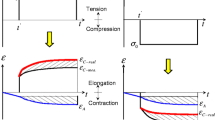Abstract
The relationship between autogenous deformation and internal relative humidity (IRH) of high-strength concrete and high-strength expansive concrete were investigated. The experimental results indicate that, there exists a good linear relationship between autogenous shrinkage and IRH of high-strength concrete but a nonlinear relationship between autogenous deformation and IRH of high-strength expansive concrete with expansive agent. The new autogenous deformation curve can be obtained by transforming the autogenous deformation data of high-strength expansive concrete, and there exists linear relationship between the autogenous deformation and IRH. The concept of “critical internal relative humidity” was proposed, which is defined as the value of IRH when autogenous deformation is zero, to effectively reflect the autogenous deformation characteristic of expansive concrete.
Similar content being viewed by others
References
Parrott L J. Factors Influencing Relative Humidity in Concrete[J]. Magazine of Concrete Research, 1991, 43(157): 45–52
Terrill J M, Richardson M, Sekby A R. Non-linear Moisture Profiles and Shrinkage in Concrete Members[J]. Magazine of Concrete Research, 1986, 38(137): 220–225
Weber S, Reinhardt HW. A New Generation of High Performance Concrete: Concrete with Autogenous Curing[J]. Adv. Cem. Based Mater., 1997, 6: 59–68
Tasdemir MA, Tasdemir C, Grimm R, et al. Role of Aggregate Fraction in the Fracture of Semi-lightweight High Strength Concrete[C]. The 6th International Symposium on Utilization of High Strength/High Performance Concrete, Leipzig; 2002: 1 453–1 466
HU Shuguang, HE Yongjia, LU Linnu. Water-releasing Factor Technology to Modify the Internal Relative Humidity of Concrete and its Application[J]. J. Railway Science and Engineering, 2006 (2): 11–14
LU Linnu, YANG Wen, WU Jing, et al. Influence of Water Absorption and Release of Water-releasing Factor on Autogenous Deformation of Concrete[J]. New Building Materials, 2008(3): 5–8
YANG Wen, LU Linnu, WU Jing, et al. Influence of Absorbing and Releasing Water Performance of Water-releasing Factor on Internal Relative Humidity of Concrete[ J]. Concrete, 2008(3): 30–35
E A B Koenders, K Van Breuget. Numerical Modeling of Autogenous Shrinkage of Hardening Cement Paste[J]. Cement and Concrete Research, 1997, 27(10): 1 489–1 499
C Hua, P Acker, A Ehrlacher. Analyses and Models of the Autogenous Shrinkage of Hardening Cement Paste (II. Modeling at Scale of Hydrating Grains)[J]. Cement and Concrete Research, 1997, 27(2): 245–258
Zhengwu Jiang, Zhenping Sun, Peiming Wang. Autogenous Relative Humidity Change and Autogenous Shrinkage of High-performance Cement Pastes[J]. Cement and Concrete Research, 2005, 35: 1 539–1 545
M Jensen, P F Hansen. Influence of Temperature on Autogenous Deformation and Relative Humidity Change in Hardening Cement Paste[J]. Cement and Concrete Research, 1999, 29(4): 567–575
Jensen O M. Thermodynamic Limitation of Self-Desiccation[J]. Cement and Concrete Research, 1995, 25(1): 157–164
Author information
Authors and Affiliations
Corresponding author
Additional information
Funded by National Natural Science Foundation of china (No. 50508034) and Guangxi Key Laboratory for the Advanced Materials and New Preparation Technology(No. 063006-5C-13), China, and National Basic Research Program of China(No.2009CB623201)
Rights and permissions
About this article
Cite this article
Hu, S., Wu, J., Yang, W. et al. Relationship between autogenous deformation and internal relative humidity of high-strength expansive concrete. J. Wuhan Univ. Technol.-Mat. Sci. Edit. 25, 504–508 (2010). https://doi.org/10.1007/s11595-010-0032-0
Received:
Accepted:
Published:
Issue Date:
DOI: https://doi.org/10.1007/s11595-010-0032-0




